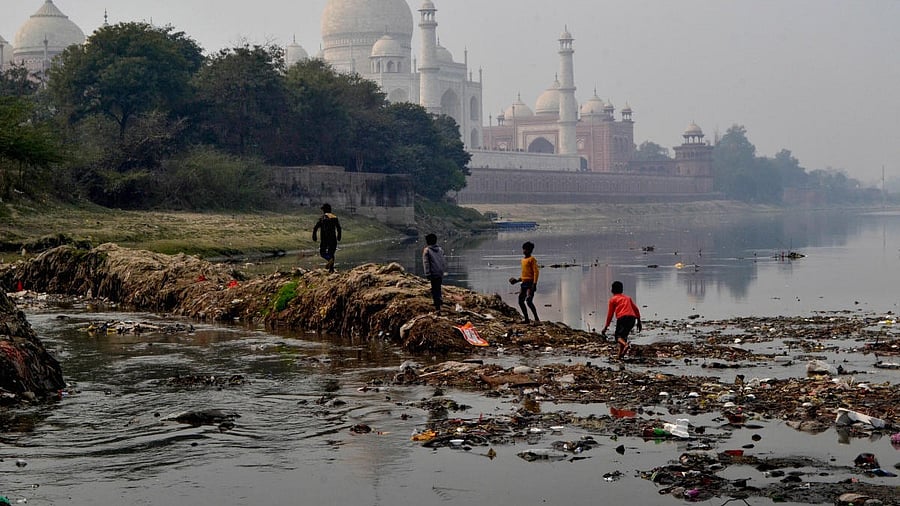
Children play on a dirty silt frozen in the Yamuna River behind Taj Mahal, in Agra.
Credit: PTI Photo
It is not possible to clean up the Yamuna River in three years. Not even if you deploy all the trash skimmers, weed harvesters, and dredgers that you can find on this side of the Ganga. Not even if you operationalise hundreds of sewage treatment plants and force all polluting industries to treat their deadly effluents to safe standards, from Uttarakhand to Uttar Pradesh, even that will not be enough to clean it in three years.
Apart from its audacity, the announcement by New Delhi’s Lieutenant Governor V K Saxena of cleaning the Yamuna in three years should not raise hopes of any real outcome, recognising that cleaning the Yamuna is as complicated as implementing Namami Ganga, India’s flagship and mostly failed river-clean-up project.
The Yamuna or Yami, the sister of Yama, the Hindu god of death, the longest river tributary of the Ganga, originates from the Yamunotri glacier in Uttarakhand and traverses through Himachal Pradesh, Haryana, and Uttar Pradesh before it enters New Delhi to die. The capital city dumps around 58 per cent of its waste into the river, with the most contamination occurring at Wazirabad, the point where the Yamuna enters Delhi. Downstream of the Wazirabad barrage, the Yamuna is biologically dead for a stretch of 22 km, where 18 significant drains discharge into the river. The river finally merges with the Ganga at Sangam in Prayagraj, Uttar Pradesh, the site of the ongoing Maha Kumbh Mela, the largest gathering of human beings alive anywhere on the planet today.
According to India’s Central Pollution Control Board, many of the sewage treatment plants in operation, including 26 out of Delhi's 35 facilities, don't comply with standards. Despite treating about 35 per cent of the sewage before release, more than 800 million litres of largely untreated wastewater and 44 million litres of industrial effluents are pumped into the Yamuna daily. The water quality of the Yamuna in Delhi is not fit for bathing. The people from Delhi alone produce an astounding 2,51,674 tonnes of plastic annually, half of which is single use. They are highly unlikely to change in three years.
The 27th report of the Parliamentary Standing Committee on Water Resources titled ‘Review of Upper Yamuna River Cleaning Projects up to Delhi and Riverbed Management in Delhi’ has flagged a usually under-played but critical issue of environmental flows or e-flows for the river. The report emphatically states that lack of adequate fresh flowing water due to upstream dams and water supply projects are the key factors behind continuous degradation of river, making all the pollution control and river cleaning projects into ineffective and futile exercises.
In addition, rampant proliferation of unplanned and mostly illegal slums, offices, and housing developments in riverbanks, wetlands, and floodplains has curtailed the flow of the river in many places. There are not enough police personnel this side of the Himalayas to stop the sandmining, groundwater extraction, and dumping of debris in the river. Industries that were shut down because they were polluting the river have been allowed to reopen or continue to operate despite being illegal.
The lieutenant governor has listed collaboration between the Delhi Jal Board (DJB), the Irrigation & Flood Control Department (I&FC), the Municipal Corporation of Delhi (MCD), the Public Works Department (PWD), the Delhi Development Authority (DDA), and the environment department, but does not feature the State Pollution Control Boards (SPCBs) — the ones who should be policing the points of pollution. The SPCBs may be ill-governed, lack transparency, have no accountability, and are the weakest link in India’s fight against environmental pollution; they are also hugely understaffed impacting their functioning, particularly in Haryana (63 per cent posts vacant), Uttarakhand (62 per cent posts vacant) and Uttar Pradesh (40 per cent posts vacant).
You can pour thousands of tonnes of cement to beautify its riverfront. You can build biodiversity parks and paint the ghats. You can pitch hundreds of miles of barbed wire fences to restrict access to the river. You can call the Yamuna holy and a lifeline, but as long as the focus remains on cleaning the river and not stopping the pollution, it is not possible to clean up the Yamuna.
Disclaimer: The views expressed above are the author's own. They do not necessarily reflect the views of DH.
[Shailendra Yashwant is a senior adviser to Climate Action Network South Asia (CANSA).]